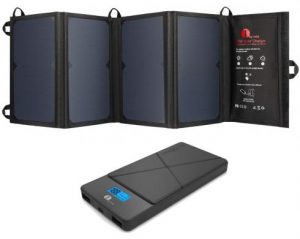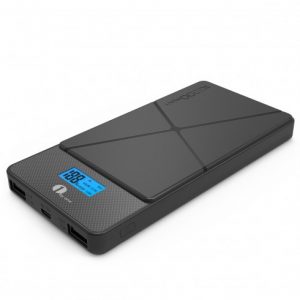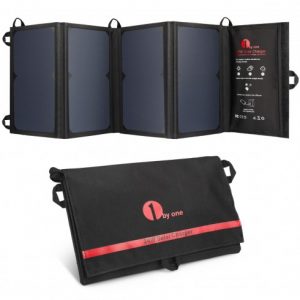 Do you live in a sunny country? Want to use the sun’s energy to charge your mobile devices? This duo of a solar charger and a USB powerbank will let you harvest the sun and charge your devices whenever you need to.
Do you live in a sunny country? Want to use the sun’s energy to charge your mobile devices? This duo of a solar charger and a USB powerbank will let you harvest the sun and charge your devices whenever you need to.
There are many power banks available, some even have solar panels directly on them. That being the case, why should you consider splitting that into two separate items? To understand the difference lets dig into the details.
Understanding Power Banks
 Powerbanks are usually sold based on their capacity in milliamp-hours (mAh). This is the capacity of the battery cells that they contain, but without knowing the voltage of the battery cells, this information is not of much use. To really understand the amount of energy stored in a power bank, its energy capacity in watt-hours (Wh) should be calculated.
Powerbanks are usually sold based on their capacity in milliamp-hours (mAh). This is the capacity of the battery cells that they contain, but without knowing the voltage of the battery cells, this information is not of much use. To really understand the amount of energy stored in a power bank, its energy capacity in watt-hours (Wh) should be calculated.
With the cell voltage and their charge capacity, the energy capacity in Wh can be calculated. For the 1byone 10,000 mAh Power Bank, the battery voltage is 3.7V and its charge capacity is 10 Ah (10000 mAh).
10 Ah * 3.7 V = 37 Wh
The voltage on a USB socket is 5V. To provide 5V from a battery with a lower voltage, a so-called step-up-controller is used. This electronic component cannot convert the voltage without introducing losses. For this calculation, these losses – as well as the loss of the charging electronics and the display on the power bank – need to be taken into consideration. Thanks to 1byone for providing the details about these components. The efficiency for the step-up-controller is 90% and for the charging electronics and display it is 75%.
The resulting power available to the outlets of the power bank is therefore calculated like this.
0.9 x 0.75 x 10000mAh = 6750mAh
The calculated 6750mAh available on the USB outlets are provided at 5V.
6750mAh * 5V = 33.75Wh
To compare this capacity with actual devices you might want to charge, the battery details for a few devices are listed below.
| Device | Voltage | Capacity | Energy |
|---|---|---|---|
| iPad Air 2 | 3.76 V | 7340 mAh | 27.62 Wh |
| iPhone 6 | 3.82 V | 1810 mAh | 6.91 Wh |
Looking at the energy column, it is clear that with the 1byone 10,000 mAh Power Bank, the iPad Air 2 can be nearly charged up from being completely empty. An iPhone 6 can be charged more then 3 times with the powerbank.
Sadly, many power banks do not provide the voltage of the battery used inside them. Without this information you can only guess about the real energy stored in them. Other vendors label their power banks with incorrect specifications. That’s why I did some tests to check if these numbers add up.
Experiences and measurements
With a USB measuring device I measured the capacity of the power bank while charging different devices.
Tests showed – in accordance with the theoretical calculations above – that an iPad can be charged from being completely empty until about 80% – 90% full. The related measurement resulted in a result of 6789mAh with 33.484Wh.
These measurements are in compliance with the theoreticaly calculated values. To get your hands on one of these power banks follow this link to amazon.com.
Solar Panels
 Solar panels like the 1byone 24W Foldable Solar Charger provide electricity from sun light. The amount of electricity produced is strongly influenced by the amount of light reaching the solar panel.
Solar panels like the 1byone 24W Foldable Solar Charger provide electricity from sun light. The amount of electricity produced is strongly influenced by the amount of light reaching the solar panel.
Sunlight should reach the solar panel as directly as possible to generate the most electricity in the solar panel. Solar panel size is also a factor for the amount of energy produced.
The most electricity is therefore produced when the solar panel is placed directly in the sun and angled directly towards the sun.
While some power banks have built in solar panels, the one I reviewed above from 1byone does not. With the mentioned points from above in mind, the size is a huge factor when placing it on the power bank. Such small panels usually produce only around 1.5 W of power. Charging a powerbank with 37 Wh like the one described above would take multiple days.
The 1byone 24W Foldable Solar Charger provides 2 USB ports in its pouch. Each USB port is specified as “Fast Charging Technology” with a maximum of 2.4A.
Experiences and measurements
Experiences with the solar panel have shown that the right angle and direct sun makes a huge difference in the amount of electricity generated. A slight layer of clouds passing in front of the sun, even if barely noticeable, caused the generated electricity to drop dramatically. Changing the angle of the 1byone 24W Foldable Solar Charger from directly angled to the sun, to a flat surface also reduced the power on the USB outlet noticeably.
To help in positioning the solar panel in the right direction facing the sun, the 1byone 24W Foldable Solar Charger has beltline hooks around it.
While charging in direct sunlight, a current of 2.3A (approx. 11W) could be achived over multiple hours when charging an iPad.
While the 1byone 10,000 mAh Power Bank charges in about 9 to 10 hours, the solar charger is able to charge the power bank as well at its maximum speed.
As with the powerbank, the 1byone 24W Foldable Solar Charger also holds up to its promise. It can be ordered directly from amazon.com.
Read more of my posts on my blog at https://blog.tinned-software.net/.


